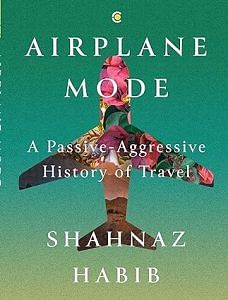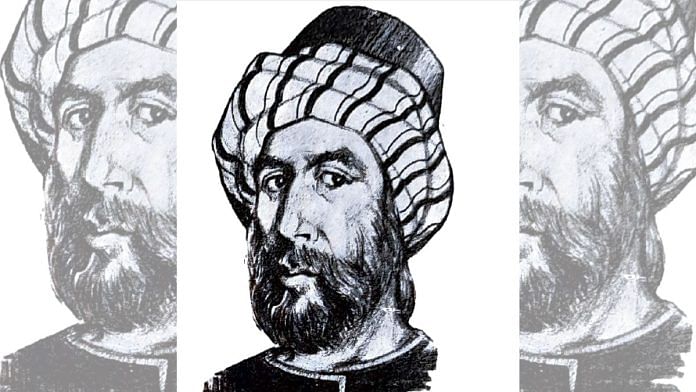Against the vacuum created by Europe’s fascination with its own hero’s journey, one medieval man stands out: Ibn Battuta, beloved of travel historians everywhere. As a young man in Tangier in North Africa, a frontier town of the fourteenth century, Ibn Battuta had set out on a pilgrimage at the age of twenty-one. One might wonder if this was not a very tender age for a pilgrimage. But, according to Ross E. Dunn, author of The Adventures of Ibn Battuta: A Muslim Traveler of the 14th Century, the hajj in Ibn Battuta’s time was almost always more than a journey to Makka and home again. Rather, it was a rihla, a grand study tour of the great mosques and madrassas of the Islamic heartland, an opportunity to acquire books and diplomas, deepen one’s knowledge of theology and law, and commune with refined and civilised men. Thus the hajj in that era was more akin to the Grand Tour that European aristocrats undertook in the seventeenth and eighteenth centuries than to the ten-day pilgrimage that we know today. It was also a ritual migration, often involving a caravan moving through the steppes of northern Africa towards Makka, collecting thousands of pilgrims on its way like a rolling snowball. Many pilgrims might have had other aims—trade or study or diplomacy—but the hajj was the overriding theme.
Looking at Ibn Battuta’s career as a traveller, I wonder if he was propelled at least as much by a quest for adventure as any spiritual desire. It was not unheard of for a hajj journey to take two or even three years in those days, but Ibn Battuta would take twenty-four years to return home. He would marry six women along the way; visit Alexandria, Cairo, and Damascus; and, after performing hajj, instead of setting off home to Morocco, he would take off towards Basra and Isfahan and Baghdad.
Wouldn’t you? Imagine being footloose and twenty-one years old and tasting the world on a platter and knowing that you can do so much better than going back to dusty little Tangier where the same old lawyer job your father and his father had done for decades is waiting for you. Instead you could be a medieval Muslim cosmopolite, caravanning off to different destinations, confident of finding hospitality and employment in any of the many newly established centres of Islamic civilisation in the farther regions of Asia and Africa. The hajj brought home to Ibn Battuta that he was not just a Moroccan lawyer; he was a citizen of Dar al-Islam, the geographic and cultural span of the Islamic world. Just as Marco Polo had the good fortune of belonging to a Venetian mercantile family, Ibn Battuta lived at a time when people like him moved through the world freely and prosperously. Why would you go home?
I moved to the United States at the age of twenty-four for graduate school. My “statements of purpose” and scholarship essays were full of high-minded ideas about media and culture and education. But the truth is, I just wanted to see the world. It was all I dreamed of: being elsewhere, moving through anonymous crowds, seeing things I had only read about, being far away from the things I knew. I had no place in mind; any place would do. What were the chances for an Indian woman like me, my passport bearing the stigma of the Third World, travelling the world? An international education was my pretext, and how well it worked. Just as Ibn Battuta possibly acted more religious than he was, I pretended to be more ambitious than I was. Just as he joined the caravan of pilgrims and merchants on their way to Makka, I joined the annual caravan of international students floating towards the East Coast of the United States. I came to New York, not because I wanted to be here specifically but because it was not home. Here was a place someone would give me money to be in. Across the seven centuries separating us, I can easily sympathise with Ibn Battuta as he finishes his third hajj in Makka and, still feeling restless, sets his eye on India, the court of Muhammad bin Tughlak, the wealthiest Muslim king of the time.
The rihla of Ibn Battuta has no specific destination. At each place he arrives, Ibn Battuta figures out where to go next. He has very little loyalty, turning against previous patrons when it suits him. He is not trying to win any prizes for his country or discover new lands; he is just a Moor unmoored. So, though he is often compared to the explorers who became famous in the Age of Exploration (Columbus and da Gama and Vespucci et al.), his journey is quite different from their ambitious voyages. Ibn Battuta is a vaynokki of the world.
It was on a diplomatic mission for Tughlak that Battuta arrived in Kerala. On the Malabar coast, he survived a ship-wreck and a near-drowning. The adventures of Ibn Battuta in Kerala, but also pretty much everywhere on his travels, are a litany of troubles. He survives brigands, kidnappings, wars, shipwrecks, pirates, starvation, and disease. He stares death in the face so many times in his narrative that I lost count when I read it. And he is not a brave man! His rihla is full of honest detail about trembling with fear, begging for mercy, getting ready to meet his Maker, and then somehow surviving yet another danger, in some cases almost comically. At one point, he writes, the men who were directed to kill him forgot to, alhamdulillah, onwards and upwards.
This was the standard lot of the medieval traveller— danger, that is, not the escapes. Famously, the word travel is etymologically related to travail, which in turn has its origins in the Latin noun trapezium—a three-pronged metal device that ancient Romans used to torture prisoners. Today, for us, travel is a reprieve from the travails of work and daily life. But in those early days, travel was fraught with travail. Medieval roadways were infested with brigands while pirate ships trolled the high seas. In The Medieval Invention of Travel, Sharon Legassie points out that “in the Middle Ages, travel was nasty, brutish and long.” When setting out on a pilgrimage or a trading journey, medieval travellers could look forward to weeks and months of slow and life-threatening travel, which often meant that they were effectively severing domestic ties for the duration of their journeys. By the time Ibn Battuta returned home, his infant son and his parents were dead.
 This excerpt from Airplane Mode by Shahnaz Habib has been published with permission from Westland Books.
This excerpt from Airplane Mode by Shahnaz Habib has been published with permission from Westland Books.



